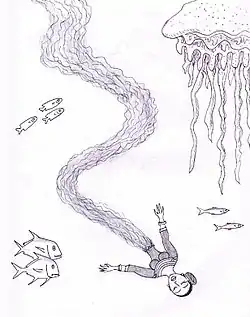Hinduism in the Maldives
Hinduism in the Maldives describes the practice of the Hindu religion in the Maldives archipelago. Hinduism generally fit between the earlier Vajrayana Buddhism and the subsequent transition to Islam. Archaeological remains survive from the 8th or 9th century CE portraying Hindu deities such as Shiva, Lakshmi and the sage Agastya.[1]

Maldivian folklore contains legends about the sage Vashishta, known locally as Oditan Kalēge, a mighty sorcerer. Oditan Kalēge's wife is the beautiful Dōgi Aihā who possesses a fiery temperament and is as powerful a sorceress as her husband. Her name is derived from the Sanskrit word Yogini.[1]
It is not known why the last Buddhist king embraced Islam. The importance of the Arabs as traders in the Indian Ocean by the 12th century may partly explain why this king acted. He adopted the Muslim title and name (in Arabic) of Sultan (discarding the old Divehi title of Maha radun or Ras Kilege) Muhammad al Adil, initiating a series of six Islamic dynasties consisting of 84 sultans and sultanas that lasted until 1932, when the sultanate became elective.
According to Merinid traveller Ibn Batuta, the person responsible for this conversion was Muslim visitor Abu al Barakat from Morocco. However, a more reliable Maldivian tradition says that he was a Persian saint from Tabriz called Yusuf Shamsuddin. He is also referred to as Tabrizugefaanu. His venerated tomb stands on the grounds of the Friday Mosque, or Hukuru miski, in Malé. Built in 1656, this is the oldest mosque in the Maldives.[2]
Don Hiyala and Alifulhu
Among Maldivian folklore in which the spirit and sorcery theme are not essential, the most significant is perhaps "Don Hiyalā and Alifulhu". This story about two good-looking lovers is a much changed, Maldivian version of the Rāmāyana. Despite the apparent dissimilarities, the common sequential structure[3] linking the elements of the Maldivian story with the Indian epic (the heroic married couple, the wicked and powerful king, the kidnapping of the beautiful heroine, etc.) is evident. This is hardly unexpected, for all South and Southeast Asian countries have local Rāmayāna variations and the Maldives is part of South Asian culture.[1]
Indians in Maldives and their status
An estimated 9,000 Indian citizens reside in the Maldives, according to 2000 census figures.
The Indian Diaspora is mainly composed of doctors, teachers, engineers, accountants, managers and other professionals. They have helped the country to develop its human resources. The group also includes skilled and unskilled personnel such as technicians, masons, tailors, plumbers and laborers.
One Maldivian citizen is of Indian origin. Both historically and commercially, south coast Indians, particularly from Kerala, were in close and regular contact with the Maldives. These contacts did not metamorphose into a composite socio-cultural group, perhaps owing to the exclusive Islamic identity of the Maldives and its people.
Officially no Maldivians are Hindus. The state religion is Sunni Islam and conversion is not allowed. Maldivian customs laws prohibit import of any idol for the purpose of worship. Hindus in the Maldives are predominantly of Tamil or Malayali origin.
References
- Xavier Romero-Frias, The Maldive Islanders, A Study of the Popular Culture of an Ancient Ocean Kingdom. Barcelona 1999, ISBN 84-7254-801-5
- History of the Maldives
- Vladimir Propp, Morphology of the Folktale, Austin, Texas, 1984, ISBN 0-292-78376-0
- Asian Variations in Ramayana. Edited by K.R. Srinivasa Iyengar. Sahitya Akademi. Delhi (1983).
- Xavier Romero-Frias, The Maldive Islanders, A Study of the Popular Culture of an Ancient Ocean Kingdom. Barcelona (1999), ISBN 84-7254-801-5
- Doń Hiyala āi Alifulu. Abdullah Sādigu, Mulī. Novelty Press. Malé (1996).